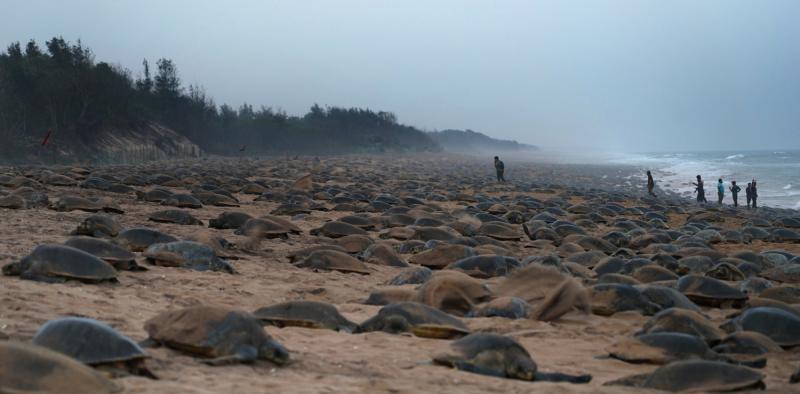
Olive Ridley Nesting in Odisha Rises Sixfold in Two Decades
In a heartening conservation success story, the nesting counts of olive ridley turtles in Odisha, India have skyrocketed over the past two decades. From a mere 25,000 annually in the early 2000s, the numbers have surged to over 150,000 in recent years. This remarkable increase is a testament to the effectiveness of concerted conservation efforts, and it underscores the importance of ongoing research and community engagement for continued success.
Olive ridley turtles (Lepidochelys olivacea) are one of the most abundant sea turtle species, found in tropical and subtropical waters around the world. They are known for their unique “arribada” nesting behavior, where large numbers of females emerge from the sea and nest simultaneously on beaches. This synchronized behavior helps to confuse potential predators and increases the chances of successful hatchlings.
The rise in olive ridley nesting in Odisha is particularly significant, as the state’s coastline has long been a critical habitat for the species. The Gahirmatha Beach, located on the eastern coast of India, is one of the largest rookeries in the world, and it has been the site of massive olive ridley nesting events for decades.
Conservation efforts have played a crucial role in the increase in olive ridley nesting in Odisha. In the early 2000s, the Indian government launched a comprehensive conservation program, which included the establishment of protected areas, habitat restoration, and research initiatives. The program also involved community engagement and education, aimed at reducing human-turtle conflict and promoting sustainable livelihoods for local communities.
One of the key strategies employed was the creation of “turtle-friendly” beaches, where human activities were minimized and habitats were restored. This included the removal of invasive vegetation, the construction of artificial nesting sites, and the establishment of turtle patrols to monitor and protect the beaches.
The conservation efforts have also focused on addressing the major threats faced by olive ridley turtles, including habitat destruction, entanglement in fishing gear, and climate change. Researchers have worked closely with local communities to develop sustainable fishing practices and to reduce pollution and habitat degradation.
The results of these conservation efforts are clear. According to the latest data, the number of olive ridley turtles nesting in Odisha has increased by over 500% in the past two decades. This is a testament to the effectiveness of conservation measures and the importance of continued research and community engagement.
However, despite these successes, new threats are emerging, and ongoing conservation efforts are necessary to ensure the long-term sustainability of olive ridley populations. For example, climate change is likely to continue to impact olive ridley habitats, and sea-level rise could lead to the loss of critical nesting sites.
Furthermore, the increasing presence of human activities, such as coastal development and tourism, poses a growing threat to olive ridley turtles. As the demand for coastal real estate and tourism infrastructure grows, the need for effective conservation measures and sustainable management practices becomes increasingly urgent.
In conclusion, the rise in olive ridley nesting in Odisha is a remarkable conservation success story, and it serves as a testament to the power of concerted conservation efforts. However, ongoing research and community engagement are crucial for continued success, and new threats must be addressed to ensure the long-term sustainability of olive ridley populations.
As we move forward, it is essential that we continue to work with local communities, governments, and international organizations to develop and implement effective conservation strategies. This includes addressing the impacts of climate change, promoting sustainable livelihoods, and protecting critical habitats.
By working together, we can ensure the long-term survival of olive ridley turtles and the ecosystems they inhabit. The success of olive ridley conservation in Odisha serves as a beacon of hope, and it reminds us that even the most seemingly insurmountable challenges can be overcome with determination, collaboration, and a commitment to conservation.
Source:
https://researchmatters.in/news/mass-nesting-olive-ridleys-thrives-new-threats-emerge






